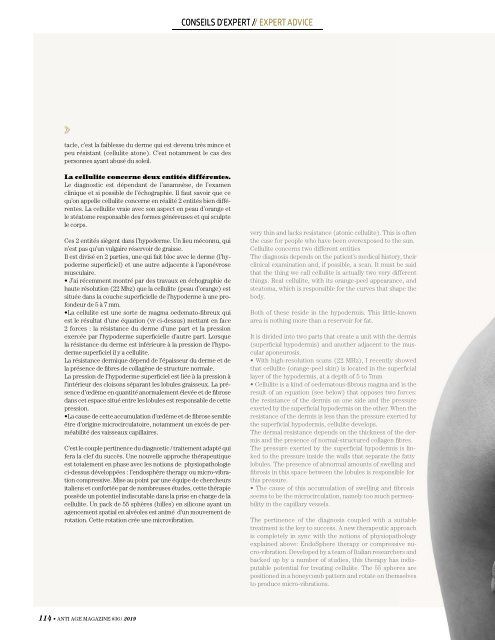ANTI-AGE #36
You also want an ePaper? Increase the reach of your titles
YUMPU automatically turns print PDFs into web optimized ePapers that Google loves.
CONSEILS D'EXPERT // EXPERT ADVICE<br />
tacle, c’est la faiblesse du derme qui est devenu très mince et<br />
peu résistant (cellulite atone). C’est notamment le cas des<br />
personnes ayant abusé du soleil.<br />
La cellulite concerne deux entités différentes.<br />
Le diagnostic est dépendant de l’anamnèse, de l’examen<br />
clinique et si possible de l’échographie. Il faut savoir que ce<br />
qu’on appelle cellulite concerne en réalité 2 entités bien différentes.<br />
La cellulite vraie avec son aspect en peau d’orange et<br />
le stéatome responsable des formes généreuses et qui sculpte<br />
le corps.<br />
Ces 2 entités siègent dans l’hypoderme. Un lieu méconnu, qui<br />
n’est pas qu’un vulgaire réservoir de graisse.<br />
Il est divisé en 2 parties, une qui fait bloc avec le derme (l’hypoderme<br />
superficiel) et une autre adjacente à l’aponévrose<br />
musculaire.<br />
• J’ai récemment montré par des travaux en échographie de<br />
haute résolution (22 Mhz) que la cellulite (peau d’orange) est<br />
située dans la couche superficielle de l’hypoderme à une profondeur<br />
de 5 à 7 mm.<br />
•La cellulite est une sorte de magma oedemato-fibreux qui<br />
est le résultat d’une équation (vr ci-dessus) mettant en face<br />
2 forces : la résistance du derme d’une part et la pression<br />
exercée par l’hypoderme superficielle d’autre part. Lorsque<br />
la résistance du derme est inférieure à la pression de l’hypoderme<br />
superficiel il y a cellulite.<br />
La résistance dermique dépend de l’épaisseur du derme et de<br />
la présence de fibres de collagène de structure normale.<br />
La pression de l’hypoderme superficiel est liée à la pression à<br />
l’intérieur des cloisons séparant les lobules graisseux. La présence<br />
d’œdème en quantité anormalement élevée et de fibrose<br />
dans cet espace situé entre les lobules est responsable de cette<br />
pression.<br />
•La cause de cette accumulation d’œdème et de fibrose semble<br />
être d’origine microcirculatoire, notamment un excès de perméabilité<br />
des vaisseaux capillaires.<br />
C’est le couple pertinence du diagnostic / traitement adapté qui<br />
fera la clef du succès. Une nouvelle approche thérapeutique<br />
est totalement en phase avec les notions de physiopathologie<br />
ci-dessus développées : l’endosphère therapy ou micro-vibration<br />
compressive. Mise au point par une équipe de chercheurs<br />
italiens et confortée par de nombreuses études, cette thérapie<br />
possède un potentiel indiscutable dans la prise en charge de la<br />
cellulite. Un pack de 55 sphères (billes) en silicone ayant un<br />
agencement spatial en alvéoles est animé d’un mouvement de<br />
rotation. Cette rotation crée une microvibration.<br />
very thin and lacks resistance (atonic cellulite). This is often<br />
the case for people who have been overexposed to the sun.<br />
Cellulite concerns two different entities<br />
The diagnosis depends on the patient’s medical history, their<br />
clinical examination and, if possible, a scan. It must be said<br />
that the thing we call cellulite is actually two very different<br />
things. Real cellulite, with its orange-peel appearance, and<br />
steatoma, which is responsible for the curves that shape the<br />
body.<br />
Both of these reside in the hypodermis. This little-known<br />
area is nothing more than a reservoir for fat.<br />
It is divided into two parts that create a unit with the dermis<br />
(superficial hypodermis) and another adjacent to the muscular<br />
aponeurosis.<br />
• With high-resolution scans (22 MHz), I recently showed<br />
that cellulite (orange-peel skin) is located in the superficial<br />
layer of the hypodermis, at a depth of 5 to 7mm<br />
• Cellulite is a kind of oedematous-fibrous magma and is the<br />
result of an equation (see below) that opposes two forces:<br />
the resistance of the dermis on one side and the pressure<br />
exerted by the superficial hypodermis on the other. When the<br />
resistance of the dermis is less than the pressure exerted by<br />
the superficial hypodermis, cellulite develops.<br />
The dermal resistance depends on the thickness of the dermis<br />
and the presence of normal-structured collagen fibres.<br />
The pressure exerted by the superficial hypodermis is linked<br />
to the pressure inside the walls that separate the fatty<br />
lobules. The presence of abnormal amounts of swelling and<br />
fibrosis in this space between the lobules is responsible for<br />
this pressure.<br />
• The cause of this accumulation of swelling and fibrosis<br />
seems to be the microcirculation, namely too much permeability<br />
in the capillary vessels.<br />
The pertinence of the diagnosis coupled with a suitable<br />
treatment is the key to success. A new therapeutic approach<br />
is completely in sync with the notions of physiopathology<br />
explained above: EndoSphere therapy or compressive micro-vibration.<br />
Developed by a team of Italian researchers and<br />
backed up by a number of studies, this therapy has indisputable<br />
potential for treating cellulite. The 55 spheres are<br />
positioned in a honeycomb pattern and rotate on themselves<br />
to produce micro-vibrations.<br />
114 • <strong>ANTI</strong> <strong>AGE</strong> MAGAZINE <strong>#36</strong> | 2019

















